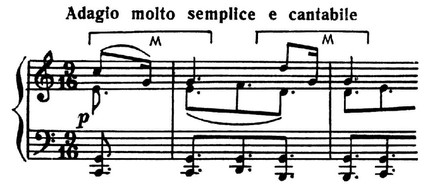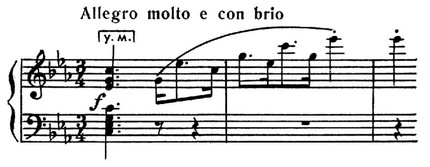
Motive |
German Motive, French motif, from lat. moveo – move
1) The smallest part of a melody, harmonic. sequence, which has semantic integrity and can be recognized among many others similar. constructions. M. also represents a certain constructive unit. As a rule, M. includes one strong beat and therefore is often equal to one bar:

L. Beethoven. Sonata for piano op. 111, part II.
Under certain conditions, the tempo, size, texture of music. prod. larger 2-bar motifs are also possible:

L. Beethoven. Sonata for piano op. 7, part I.
In some cases, M. is divided into smaller constructive cells, called submotives. The submotive does not have semantic integrity and exists only as part of the whole:

F. Chopin. Sonata b-moll for piano, movement I.
Usually a metric consists of metrically weak and strong tenses or, conversely, strong and weak tenses. There are also M., consisting of only one, strong, time. They are called truncated M.:

L. Beethoven. Sonata for piano op. 10 No 1, part I.
M. can be combined in twos and threes in phrases or in larger constructions. At the same time, they are clearly separated from each other or merge into one whole. In some cases, continuous, connected melodic. division into motives turns out to be impossible.
M. or a row of M. (usually two), with which music begins. the theme of a homophonic product, form its core. Further development within the theme brings to life certain changes in the initial M. or new M. At the end of the theme, the final M sounds. The theme underlies the form of the whole work, in which it is compared with other themes and develops. Thematic development consists mainly in the repeated holding of sections. variants of one theme, singling out (singling out) individual motifs from it, and colliding them with the motives of other themes.
Of particular tension thematically. development reaches in the development of sonata form. This development is often a continuous stream of phrases, M. – “fragments” of previously stated topics. At the same time, M. can be subjected to decomp. transformations. Their constituent intervals, the direction of the melodic ones can change. movements (ascending to be replaced by descending, and vice versa), their harmonic. filling; they can get involved. sort of polyphonic. connections. At the same time, rhythmic remains the most stable element. the drawing is his creatures. changes in some cases can completely destroy the given M. and create, in fact, a new one.
Some music. prod. represent the continuous development of one M. In them, only from time to time new M. appear, accompanied, however, by the sound of the main one or representing its variants. Yes, music. the development in the first movement of Beethoven’s 5th symphony follows from the initial four-beat motif:

This kind of steady development of one M. is widely represented in the works of Beethoven and Schumann.
The first attempts to develop the doctrine of M. were made in the 2nd floor. 18th century I. Mattheson, J. Ripel and G. K. Koch. At the same time, the term “M.” they did not apply. It originates from Italy, where it meant in the 18th century. main thematic aria core. The most important contribution to the doctrine of M. was made in the 19th century. AB Marx and in particular X. Riemann. Unlike R. Westphal and T. Wiemeyer, Riemann understood music not only as a rhythmic formation, but also as a unity of rhythmic, melodic, harmonic, dynamic, and timbre factors.
The weak side of the Riemannian doctrine of M. is the recognition of the real existence of only iambic (from a weak share to a strong), but not choreic M. In Russia, the doctrine of M. was developed by S. I. Taneev.
2) In the everyday sense – a melody, a melody, a tune.
References: Catuar G., Musical form, part 1-2, M., 1934-36; Sposobin I. V., Musical form, M.-L., 1947, M., 1962; Mazel L., Structure of musical works, M., 1960; Tyulin Yu. N., The structure of musical speech, L., 1962; Arzamanov F., S. I. Taneev – teacher of the course of musical forms, M., 1963; Mazel L., Zukkerman V., Analysis of musical works, part 1, M., 1967. See also lit. under the article Musical form.
V. P. Bobrovsky



